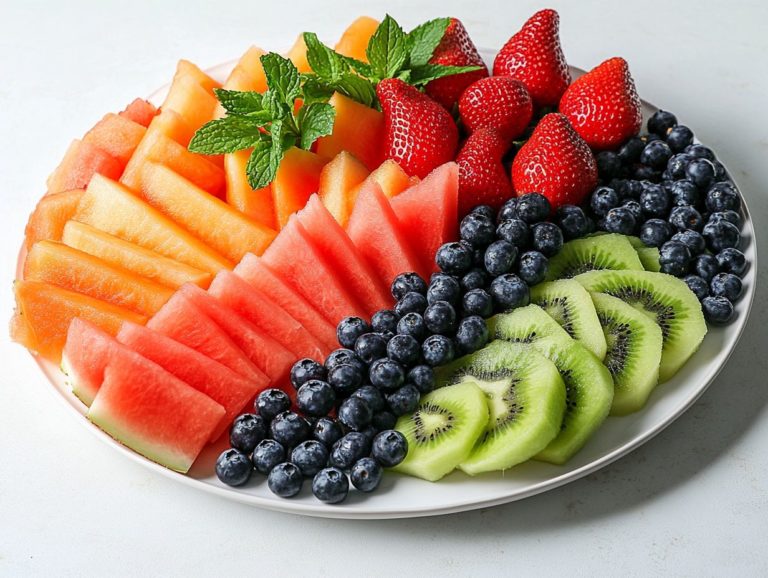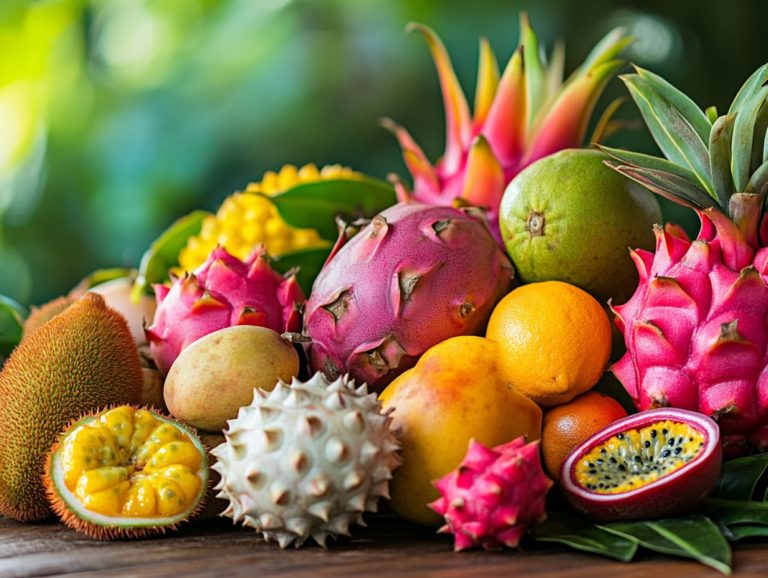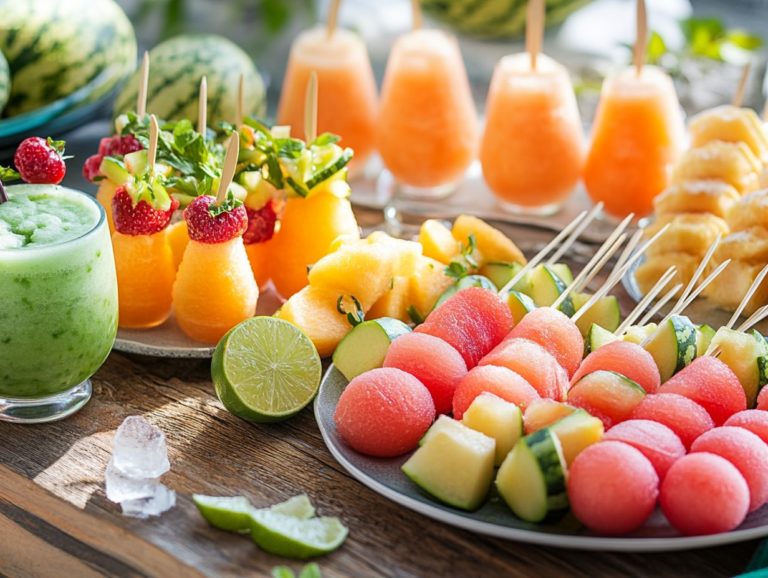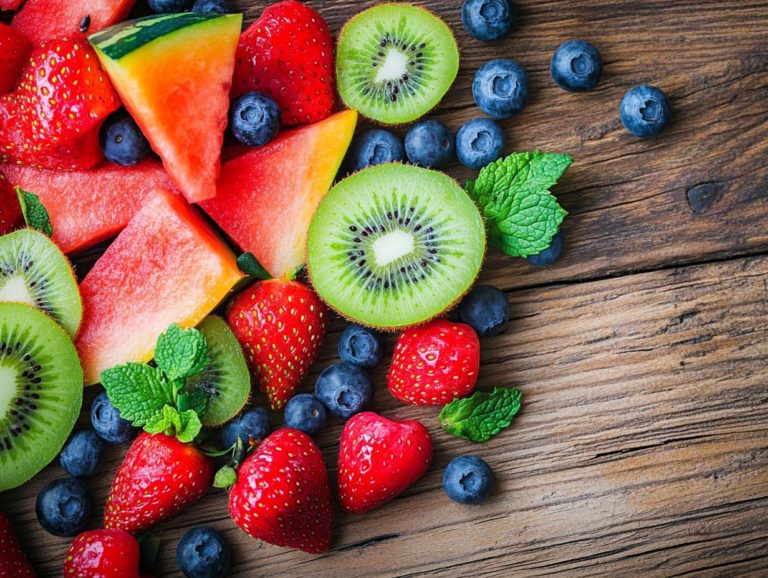The Science Behind Fruit Ripening
Fruit ripening is a fascinating natural process that transforms hard, green produce into sweet, colorful delights through chemical and physical changes.
By understanding how and why fruits ripen, you deepen your appreciation for these foods while uncovering the complex interplay of hormones, environmental conditions, and the changes involved.
This discussion will guide you through the stages of fruit ripening, the roles of various hormones such as abscisic acid and ethylene, and the influence of external conditions.
You will also explore how ripening can be controlled using various inhibitors and the unique processes associated with different types of fruit, including climacteric and non-climacteric fruits.
Prepare to delve into the science behind this essential agricultural phenomenon, including the role of chemical signals and the various ripening agents involved.
Contents
- Key Takeaways:
- What is Fruit Ripening?
- What Causes Fruit to Ripen?
- What Hormones are Involved in Fruit Ripening?
- What External Factors Affect Fruit Ripening?
- What are the Physical Changes that Occur during Fruit Ripening?
- What Happens to the Color of the Fruit?
- What are the Chemical Changes that Occur during Fruit Ripening?
- What Happens to the Starch Content of the Fruit?
- What Happens to the Acidity of the Fruit?
- How is Fruit Ripening Controlled?
- What Are the Factors that Affect the Ripening of Different Fruits?
- Frequently Asked Questions
- What exactly is the science behind fruit ripening?
- Why do fruits ripen and what are the stages of ripening?
- What is ethylene gas and how does it affect fruit ripening and maturation?
- How do temperature and humidity affect fruit ripening and storage conditions?
- Can you control the ripening process of fruits and manage their ripening agents?
- Is there a difference in the ripening process of different types of fruits, including climacteric and non-climacteric varieties?
Key Takeaways:

Key Points:
- The ripening of fruit is a complex process involving physical and chemical changes controlled by hormones and external factors.
- Hormones such as ethylene and auxins play a crucial role in fruit ripening. Temperature, humidity, and light can also affect the process.
- Ripening leads to changes in color, texture, and flavor, as well as an increase in sugar content, including glucose and fructose, and a decrease in starch and acidity. Controlling ripening can prolong shelf life and improve quality.
What is Fruit Ripening?
Fruit ripening is a fascinating biological journey marked by a series of intricate physiological changes that transition fruit from an immature state to one of maturity. This significantly enhances its palatability and visual appeal for consumption.
This transformation varies considerably across different fruit types. Take climacteric fruits, such as bananas and tomatoes. They experience notable changes driven by ripening hormones like ethylene. This signaling molecule kicks off the ripening process, influencing key factors such as sweetness, acidity, and the overall flavor profile.
What are the Stages of Fruit Ripening?
The stages of fruit ripening can be categorized into several key phases. It starts with the initiation of ripening, triggered by ethylene production in climacteric fruits, and culminates in full maturation. This is marked by noticeable changes in texture, color, and flavor.
Different fruits exhibit unique ripening stages influenced by the synthesis of various compounds and the rate of respiration. During these stages, chemical changes play a pivotal role, particularly in climacteric fruits like bananas and tomatoes.
They experience a surge in ethylene production that stimulates respiration. This leads to the breakdown of starches into sugars, enhancing their sweetness. In contrast, non-climacteric fruits, such as berries and grapes, take a more gradual approach. They do not respond to ethylene in the same way and ripen steadily without the spike in respiration rates.
The ripening process involves the enzymatic breakdown of polysaccharides, leading to increased palatability and sweetness. As these fruits transition from pre-ripe to ripe, chlorophyll degrades. This makes way for vibrant pigments like carotenoids and anthocyanins to shine through, contributing to their appealing hues.
Meanwhile, acids soften as pectin breaks down, resulting in improved texture. Understanding these intricate changes reveals the captivating science behind fruit development and assists in optimizing harvesting and post-harvest handling for the best experience.
What Causes Fruit to Ripen?
Fruit ripening primarily occurs due to the production of hormones and various ripening agents, with ethylene taking center stage. This remarkable gas initiates a cascade of processes, ultimately leading to desirable traits such as enhanced sweetness and improved texture, especially in beloved fruits like bananas and tomatoes.
What Hormones are Involved in Fruit Ripening?
The primary hormones involved in fruit ripening include ethylene, a key signaling molecule, and abscisic acid. Together, they orchestrate the intricate changes essential for the maturation and ripening stages of fruits like apples, peaches, and guava.
These hormones play critical roles in regulating various biochemical pathways. They ultimately transform characteristics such as color, texture, and flavor. For example, ethylene stimulates the production of enzymes like polygalacturonase and cellulase. These enzymes break down cell wall components, resulting in the delightful softening of fruits like bananas and tomatoes.
Meanwhile, abscisic acid helps accumulate sugars, enhancing the sweetness of ripe strawberries. Other compounds, such as methyl jasmonate and potassium permanganate, also influence the ripening process.
As these hormones interact, they create a delicate balance. This balance affects not only the development of the fruits but also the timing and conditions under which they achieve optimal ripeness. It reveals the remarkable complexity of nature’s design.
What External Factors Affect Fruit Ripening?
External factors like temperature, humidity, and light exposure greatly impact how fruit ripens. By creating optimal storage conditions, you can promote rapid ripening. Conversely, certain inhibitors can slow the process, helping to preserve quality during transport and extending shelf life.
Managing these environmental conditions effectively can minimize fruit spoilage and ensure peak palatability.
Temperature is particularly crucial. While higher temperatures can speed up ripening, leaving fruits in those conditions for too long can lead to spoilage. Humidity levels are equally important; excessive moisture can encourage mold growth, while low humidity can dry out the fruit, diminishing its overall quality. Proper storage conditions can help maintain the delicate balance between ripening and spoilage.
Light exposure also matters, as some fruits require minimal light to keep their color and texture intact. By meticulously managing these environmental factors throughout storage and distribution, you can optimize fruit quality, prolong freshness, and minimize waste. Ultimately, you’ll ensure that consumers receive the finest products.
What are the Physical Changes that Occur during Fruit Ripening?
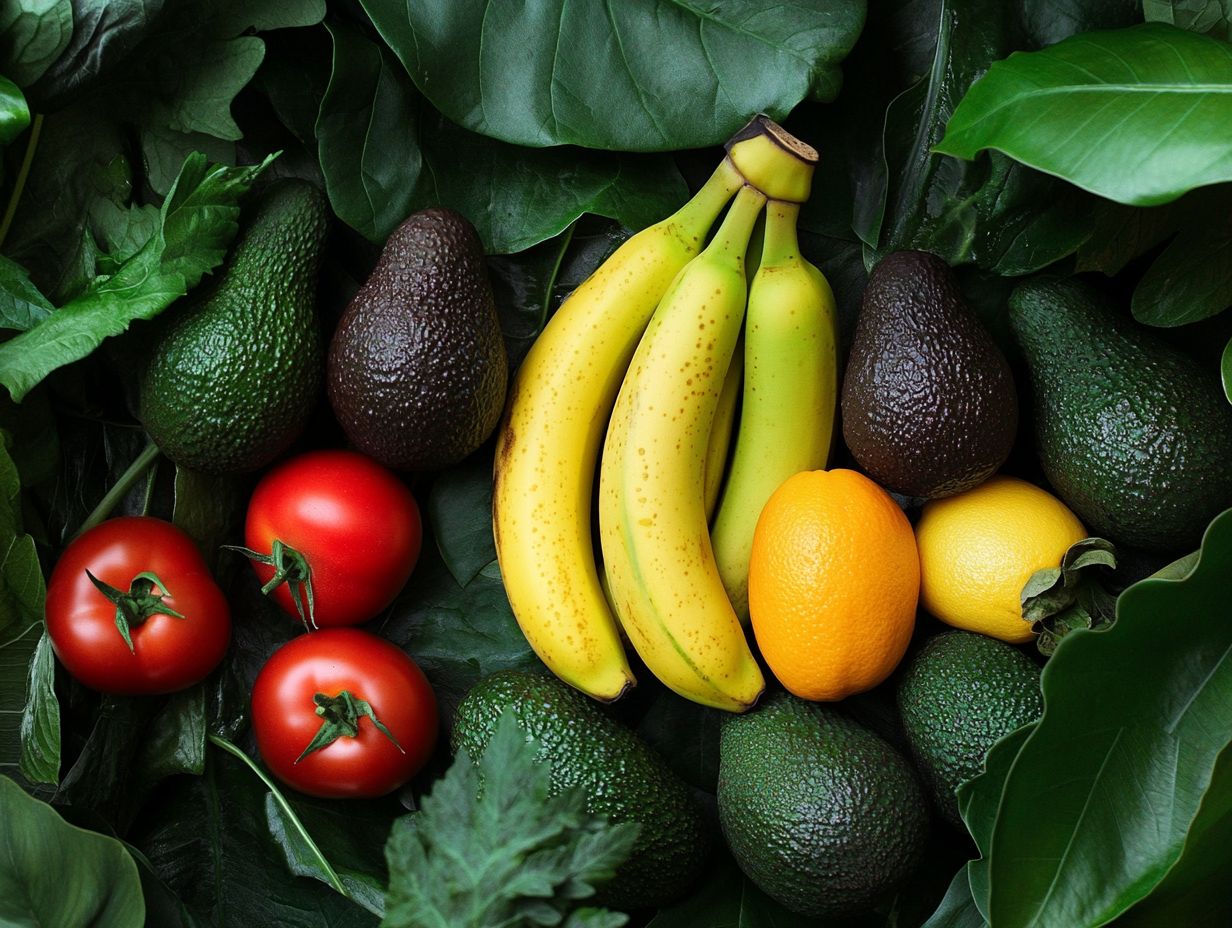
The physical transformations that take place during fruit ripening are truly remarkable! You’ll notice variations in texture, vibrant color changes as chlorophyll breaks down, and shifts in firmness and softness. These changes are the result of enzymes breaking down polysaccharides and other cellular structures.
These changes not only enhance the fruit’s overall appeal and palatability but also serve as indicators of potential spoilage. Monitoring these physical changes is crucial for optimizing harvest and storage conditions.
What Happens to the Color of the Fruit?
During the ripening of fruit, one of the most striking changes you ll notice is the transformation in color. This remarkable shift is primarily driven by the breakdown of chlorophyll and the increased production of pigments like carotenoids and anthocyanins. These pigments enhance the allure of fruits such as strawberries and peaches. This color change is a key indicator of ripeness and is influenced by environmental conditions and ripening agents.
As the fruit matures, an intricate dance begins. Enzymes spring into action to initiate the degradation of chlorophyll. This process gradually reveals the vibrant colors beneath. Take bananas, for example; their green skin transforms into bright yellow thanks to a surge in carotenoid pigments, particularly beta-carotene. Likewise, tomatoes transition to a rich red hue as lycopene accumulates following the breakdown of chlorophyll.
These biochemical reactions do more than just provide a visual spectacle; they also signal that the fruit is ready for consumption. This transformation attracts animals and humans, ensuring successful seed dispersal and aiding in the cycle of plant reproduction. The breakdown of bitter substances and the synthesis of new compounds enhance the fruit’s palatability.
What Happens to the Texture of the Fruit?
The texture of fruit undergoes remarkable changes during the ripening process, as cellular structures soften due to the breakdown caused by enzymes of polysaccharides and cellulose. This process results in a delightful transition from firm to soft, particularly noticeable in fruits like bananas and mangoes.
The breakdown of cellulose and starch into simpler sugars like glucose significantly enhances the texture and sweetness of the fruit. This transformation hinges on the action of enzymes such as pectinase and cellulase, which are types of enzymes that help break down sugars and dismantle the components that give fruits their initial sturdiness.
As you savor fruits like peaches and avocados at their peak ripeness, you not only enjoy their sweeter flavor but also the irresistible creamy texture that emerges during this softening process. In contrast, apples maintain a firmer texture even as they ripen, showcasing the diversity in consumer preferences across various types of fruit.
Ultimately, the journey from crisp and crunchy to soft and juicy resonates with your taste preferences, illustrating how these texture changes can significantly enhance or diminish the appeal of different fruits in the marketplace. The hydrolysis of polysaccharides plays a crucial role in these texture changes.
What Happens to the Flavor of the Fruit?
As fruits ripen, you ll notice a remarkable evolution in their flavor profile. They become sweeter due to sugar accumulation.
The acidity diminishes, and complex aromas develop, enhancing their overall appeal. This transformation is driven by biochemical processes, where enzymes such as amylase break down starch into sugars, resulting in a much sweeter experience with fruits like bananas as they mature.
Consider the initially tangy green mango; it undergoes a delightful metamorphosis as its organic acids fade and sugars rise, creating a luscious, fragrant experience that captivates your taste buds. The increase in sweetness is accompanied by the degradation of bitter substances and the synthesis of aromatic compounds.
During ripening, volatile compounds and aromas are produced, adding to the rich aroma of fruits like strawberries and peaches. This enticing fragrance not only pleases your senses but also indicates the perfect moment for consumption. These intricate changes in flavor are nature s way of attracting animals for seed dispersal, ensuring you can fully enjoy the delightful bounty that the earth has to offer.
What are the Chemical Changes that Occur during Fruit Ripening?
During the ripening process, you’ll witness a fascinating array of chemical transformations. Starches convert into delightful sugars such as glucose and sucrose, while organic acids break down, contributing to an improved taste profile.
Flavorful compounds are synthesized, elevating the palatability of fruits like apples and pears to new heights.
What Happens to the Sugar Content of the Fruit?
As fruits ripen, prepare to be amazed by the significant increase in sugar content, primarily because starch is converted into simple sugars like glucose and sucrose. This transformation leads to the delightful sweetness that consumers crave.
This biochemical process is largely driven by specific enzymes, such as amylase and invertase, which break down the starches stored in the fruit s tissues into simpler carbohydrates and compounds. For example, bananas and mangoes perfectly illustrate this phenomenon; they begin with a high starch content and gradually become sweeter as these enzymes work their magic during ripening.
The climacteric rise in respiration rates during ripening plays a crucial role in this process, enhancing both the rate of starch hydrolysis and the synthesis of sugars. As a result, ripe fruits become irresistibly appealing.
This natural sweetness attracts consumers and draws in beneficial insects for pollination, vital for the fruit’s reproduction.
What Happens to the Starch Content of the Fruit?
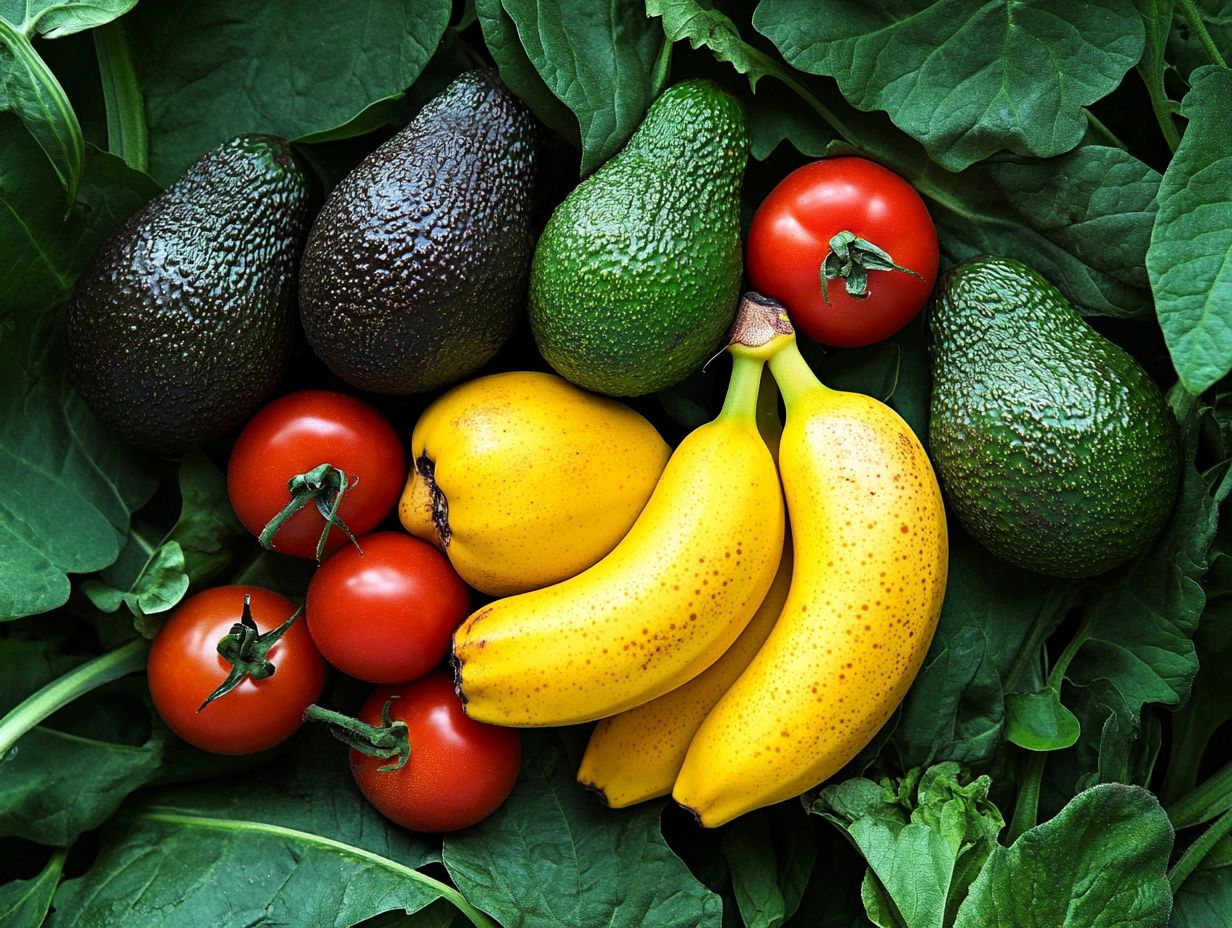
The starch content in fruit diminishes significantly during ripening. This fascinating process involves enzymes breaking down stored starches into simpler sugars. This not only contributes to the sweet taste but also elevates the overall quality of the fruit.
This transformation is essential for fruits like bananas, apples, and mangoes. As complex carbohydrates break down, they enhance sweetness and improve texture. This change makes the fruit softer and more enjoyable to eat. Enzymes such as amylase play a crucial role in catalyzing this reaction. They skillfully shift the balance between starch and sugar, creating a more appealing profile for consumption.
As the fruits ripen, their starch levels decline. This leads to a gradual increase in glucose and fructose. This shift creates that delightful burst of flavor you savor. The entire process influences your eating experience, enhancing juiciness and tenderness qualities that are highly sought after for anyone looking for a truly flavorful snack.
What Happens to the Acidity of the Fruit?
During the ripening process, you’ll be surprised to find a decline in the acidity of fruit as organic acids break down. This enhances the sweetness and significantly transforms the overall flavor profile, making the fruit far more appealing to you as a consumer.
This transformation results from several biochemical processes, such as the breakdown of citric and malic acids, which are predominant in many fruits. As these acids diminish, the natural sugars produced during photosynthesis come forward, contributing to that delightful sweet taste you crave.
Take tomatoes and strawberries, for example; both display a noticeable decrease in acidity as they ripen. This leads to a richer, more enjoyable flavor. This change doesn’t just enhance palatability; it also influences aroma and nutrient availability, ultimately creating a direct link between ripeness and your enjoyment of the fruit.
How is Fruit Ripening Controlled?
You can effectively control the ripening of fruit through a variety of sophisticated methods. Whether your goal is to enhance or inhibit the process, there are several options available.
This may involve the application of specific chemicals, careful management of storage conditions, or the manipulation of controlled atmospheric conditions to adjust ethylene levels and manage ripening agents.
What are the Methods of Controlling Fruit Ripening?
You have various methods at your disposal for controlling fruit ripening. These include the use of ethylene gas, potassium permanganate, and specific storage conditions tailored to either accelerate or delay the ripening process, depending on the fruits you’re working with like bananas and tomatoes.
By thoughtfully managing the concentration of ethylene, a natural plant hormone, and using potassium permanganate as a scrubber to absorb any excess ethylene, you can optimize the ripening process. This is especially important in large-scale agricultural operations. For instance, commercial ripening facilities often employ ethylene chambers designed to meticulously regulate temperature and humidity. This ensures that every batch ripens uniformly.
On a consumer level, you can easily adopt simple practices. For example, store fruits in certain environments or place them alongside ethylene-producing fruits. These methods can help you achieve that perfect ripeness right in your own kitchen. By utilizing these strategies, you minimize waste and elevate the overall quality of the fruits you enjoy.
In conclusion, understanding the science of fruit ripening empowers you to enhance your fruit experience, whether you are a consumer or a farmer. The interplay of starch, sugar, acidity, and the methods to control ripening all contribute to the delightful flavors we enjoy.
What Are the Benefits of Controlling Fruit Ripening?
Controlling fruit ripening presents you with a wealth of advantages, including the ability to extend shelf life, preserve quality, and cater to consumer preferences for flavor and texture. This enhances marketability. It also significantly reduces food waste.
This process not only aligns your products with the demands of consumers but also minimizes economic losses linked to spoilage. For example, in the banana and tomato industries, the application of ethylene gas synchronizes the ripening process, ensuring that fruits arrive at the marketplace perfectly timed for consumption.
Innovative packaging solutions, such as special packaging that changes the air around fruits to keep them fresh, fortify this objective, allowing for prolonged freshness during transportation and storage. By embracing these techniques, you can elevate the overall quality of your fruits, boost customer satisfaction, and drive sales to new heights.
What Are the Factors that Affect the Ripening of Different Fruits?
The ripening of various fruits is shaped by a multitude of factors, including specific environmental conditions, the type of fruit, and the presence of ripening agents or inhibitors. These elements can profoundly affect both the timing and the quality of the ripening process.
What Are the Differences in Ripening Processes for Different Fruits?
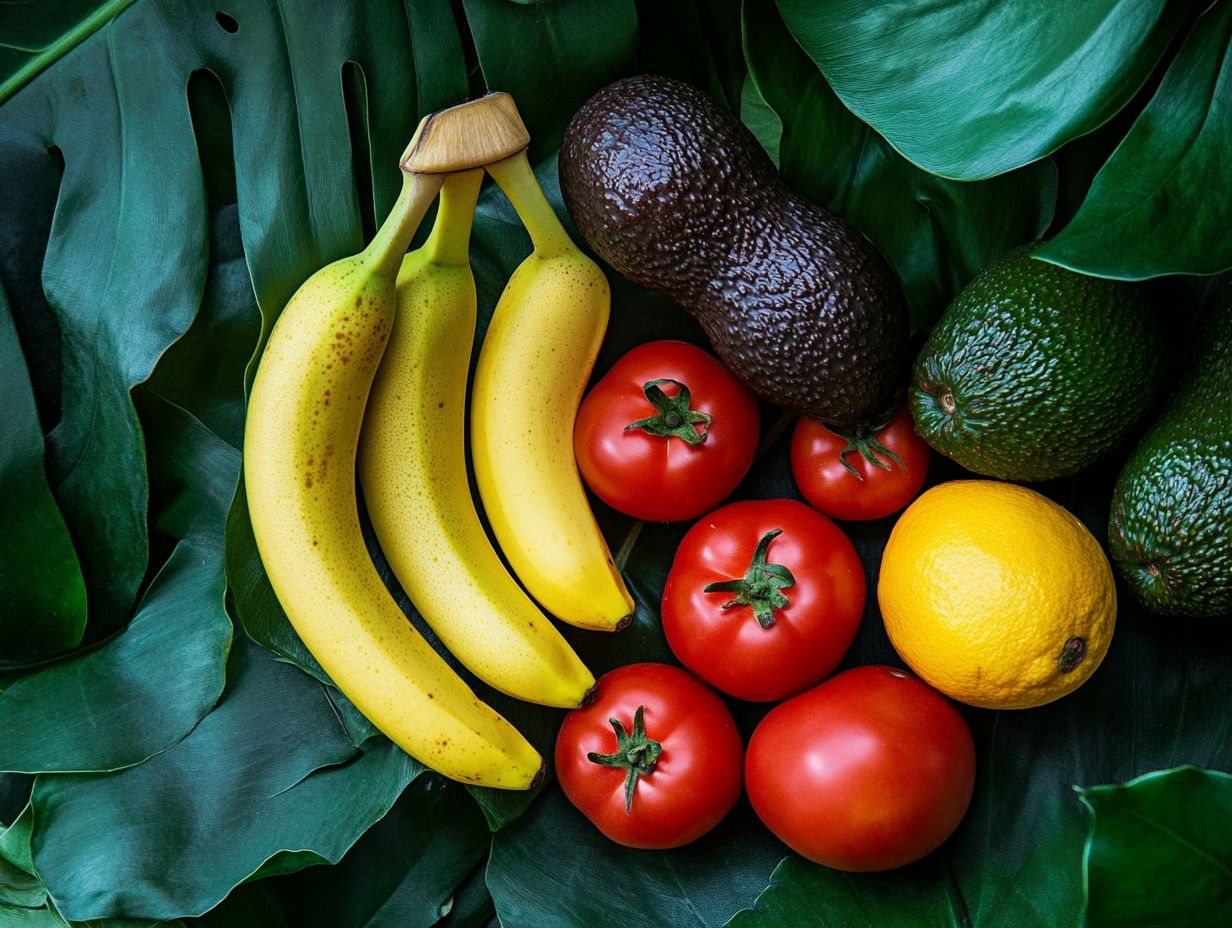
The ripening processes for different fruits can vary significantly, especially when comparing climacteric fruits, which continue to ripen after harvest, to non-climacteric fruits, which do not. This distinction leads to different handling and storage approaches that are essential to grasp.
Take climacteric fruits like bananas, avocados, and tomatoes. These fruits release ethylene gas during the ripening process, triggering further maturation that can be managed to extend their shelf life. This unique trait empowers farmers to harvest them just before peak ripeness, ensuring the best taste for you!
On the other hand, non-climacteric fruits, such as strawberries, cherries, and grapes, do not continue to ripen once they are picked. Therefore, it s crucial to harvest them at their peak ripeness to guarantee the best flavor and freshness.
Understanding these differences is not just an agricultural insight; it also gives you the power as a consumer to make informed decisions on how to store these fruits, helping to maintain their quality for longer periods.
What Are the Optimal Conditions for Ripening Fruits?
Optimal conditions for ripening differ based on the type of fruit, with key factors such as temperature, humidity, and ethylene exposure playing vital roles in enhancing quality and flavor during the ripening process.
Take bananas, for example; they flourish in warmer temperatures around 60 to 70 F, a sweet spot where ethylene production spikes, accelerating their ripening and boosting their natural sweetness. On the other hand, apples thrive in cooler conditions, ideally between 30 and 40 F, which effectively slows down the ripening process and helps them retain their coveted crispness.
Humidity is another crucial element in determining fruit quality. Higher humidity levels can be your ally in preventing moisture loss, which is essential for juicy fruits like peaches. However, beware of excessive moisture, as it can lead to spoilage.
Controlled atmospheres, particularly low oxygen environments, are advantageous for storing fruits like avocados. This technique delays their ripening, granting them a longer shelf life while still optimizing flavor when the moment arrives for enjoyment.
Frequently Asked Questions
What exactly is the science behind fruit ripening?
The science behind fruit ripening is a complex process that involves changes in a fruit’s color, texture, and flavor. It is a natural process that allows fruits to become sweeter and more appealing to animals, which helps in seed dispersal. This process also involves the enzymatic breakdown of starch into simpler sugars like glucose and fructose, contributing to the sweetness and overall palatability of the fruit.
In summary, understanding the dynamics of fruit ripening not only benefits producers in managing their crops but also empowers consumers to make informed choices, ensuring they enjoy the freshest and most flavorful fruits available.
Why do fruits ripen and what are the stages of ripening?
Fruits ripen as part of their natural growth cycle. As they mature, the level of ethylene gas produced increases, which causes the fruit to soften and change color.
The synthesis of ethylene gas is a key factor in this process. It is necessary for the fruit to become edible and attractive to animals for seed dispersal. For example, climacteric fruits like bananas and tomatoes exhibit a distinct ripening stage marked by a surge in ethylene production.
What is ethylene gas and how does it affect fruit ripening and maturation?
Ethylene gas is a plant hormone that plays a crucial role in fruit ripening. It initiates the production of enzymes that break down the fruit’s cell structure, making it softer and sweeter.
Ethylene also helps produce pigments that give fruits their color. It can also lead to the synthesis of aromas and flavors that improve a fruit’s taste.
How do temperature and humidity affect fruit ripening and storage conditions?
Temperature and humidity play a significant role in fruit ripening. Higher temperatures and humidity levels can speed up the ripening process, while lower temperatures can slow it down.
This is why fruits are often stored in controlled environments to maintain their freshness and prevent them from overripening. Environmental conditions can influence the degradation of polysaccharides like cellulose and the accumulation of bitter substances and organic acids, thus affecting the fruit’s overall sweetness and consumer preferences.
Can you control the ripening process of fruits and manage their ripening agents?
Yes, you can take charge of how fruits ripen! Exposing them to ethylene gas can speed things up, while storing them in a cool, dry place can slow the process down.
Chemicals like potassium permanganate and methyl jasmonate can serve as ripening agents or inhibitors to manage this process. Some fruits, like bananas and mangoes, can also be harvested while green and ripened off the tree.
Is there a difference in the ripening process of different types of fruits, including climacteric and non-climacteric varieties?
Yes, there can be variations in the ripening process of different fruits. Some fruits, like apples, ripen after they are picked, while others, like strawberries, need to ripen on the plant.
Climacteric fruits like peaches and pears exhibit a spike in respiration and ethylene production, whereas non-climacteric fruits like guava have a different ripening switch. Moreover, the levels of ethylene gas and enzymes produced during ripening can differ among various fruits, affecting their texture, sweetness increase, and taste.
Factors like the degradation of chlorophyll and the synthesis of sucrose and fructose also play roles in these processes.

